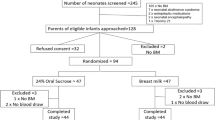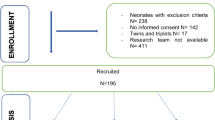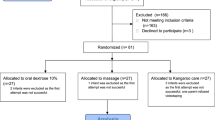Abstract
Objective:
The objective of this study was to evaluate and compare the efficacy of combined sucrose and non-nutritive sucking (NNS) for analgesia in newborn infants undergoing heel-stick procedures.
Study Design:
This randomized control trial was conducted in the neonatal intensive care unit of a tertiary care hospital over a period of 1 year. One hundred and eighty full-term neonates with birth weight >2200 g and age >24 h were randomized to one of four interventions administered 2 min before the procedure: 2 ml of 30% sucrose (group I, n=45) or NNS (group II, n=45) or both (group III, n=45) or none (group IV, n=45). Primary outcome was composite score based on Premature Infant Pain Profile (PIPP) score.
Result:
Baseline variables were comparable among the groups. Median (interquartile range) PIPP score was 3 (2 to 4) in group III as compared with 7 (6.5 to 8) in group I, 9 (7 to 11) in group II and 13 (10.5 to 15) in group IV. Group III had significant decrease in the median PIPP score compared with other groups (P=0.000). Median PIPP score also decreased significantly with any intervention as compared with no intervention (P=0.000).
Conclusion:
Sucrose and/or NNS are effective in providing analgesia in full-term neonates undergoing heel-stick procedures, with the combined intervention being more effective compared with any single intervention.
This is a preview of subscription content, access via your institution
Access options
Subscribe to this journal
Receive 12 print issues and online access
$259.00 per year
only $21.58 per issue
Buy this article
- Purchase on Springer Link
- Instant access to full article PDF
Prices may be subject to local taxes which are calculated during checkout

Similar content being viewed by others
References
Gibbins S, Stevens B, Hodnett E, Pinelli J, Ohlsson A, Darlington G . Efficacy and safety of sucrose for procedural pain relief in preterm and term neonates. Nurs Res 2002; 51: 375–382.
Wolf AR . Analgesia in the Neonates, 4th edn. Elsevier: Oxford, UK, 2005.
Gleiss J, Stuttgen G . Morphologic and functional development of the skin. In: Stave U (ed). Physiology of the Perinatal Period. Appleton-Century Crofts: New York, NY, USA, 1970, pp 889–906.
Hall RW, Anand KJS . Short and long term effects of neonatal pain and stress: more than an ouchie. Neoreviews 2005; 6: e69–e75.
Goldman RD, Koren G . Biological markers of pain in the vulnerable infant. Clin Perinatol 2002; 29: 415–425.
Stevens B, Johnston C, Petryshen P, Taddio A . Premature infant pain profile: development and initial validation. Clin J Pain 1996; 12: 13–22.
Ballantyne M, Stevens B, McAllister M, Dionne K, Jack A . Validation of the premature infant pain profile in the clinical setting. Clin J Pain 1999; 15: 297–303.
Anand KJ . Pharmacological approaches to the management of pain in the neonatal intensive care unit. J Perinatol 2007; 27: S4–S11.
Vani SN, Nimbalkar S, Thakre R . Assessment and Management of Pain in the Newborn. NNF Clinical Practical Guidelines: NNF Publication, 2010, pp 199–215. Available at: http://www.ibrarian.net/navon/paper/NNF_Clinical_Practice_Guidelines.pdf?paperid=21085669 (last accessed on January 2015).
Stevens B, Johnston C, Franck L, Petryshen P, Jack A, Foster G . The efficacy of developmentally sensitive interventions and sucrose for relieving procedural pain in very low birth weight neonates. Nurs Res 1999; 48: 35–43.
Mathai S, Natrajan N, Rajalakshmi NR . A comparative study of non pharmacological methods to reduce pain in neonates. Indian Pediatr 2006; 43: 1070–1075.
Stevens B, Yamada J, Lee GY, Ohlsson A . Sucrose for analgesia in newborn infants undergoing painful procedures. Cochrane Database Syst Rev 2013; 1: CD001069.
Taddio A, Shah V, Hancock R, Smith RW, Stephens D, Atenafu E et al. Effectiveness of sucrose analgesia in newborns undergoing painful medical procedures. CMAJ 2008; 179: 37–43.
Gray L, Miller LW, Philipp BL, Blass EM . Breastfeeding is analgesic in healthy newborns. Pediatrics 2002; 109: 590–593.
Sexton S, Natale R . Risks and benefits of pacifiers. Am Fam Physician 2009; 79: 681–685.
Carbajal R, Chauvet X, Couderc S, Olivier-Martin M . Randomised trial of analgesic effects of sucrose, glucose, and pacifiers in term neonates. BMJ 1999; 319: 1393–1397.
Author information
Authors and Affiliations
Corresponding author
Ethics declarations
Competing interests
The authors declare no conflict of interest.
Rights and permissions
About this article
Cite this article
Thakkar, P., Arora, K., Goyal, K. et al. To evaluate and compare the efficacy of combined sucrose and non-nutritive sucking for analgesia in newborns undergoing minor painful procedure: a randomized controlled trial. J Perinatol 36, 67–70 (2016). https://doi.org/10.1038/jp.2015.122
Received:
Revised:
Accepted:
Published:
Issue Date:
DOI: https://doi.org/10.1038/jp.2015.122
This article is cited by
-
Effect of eye shield and ear muffs on pain intensity during venous blood sampling in premature infants: a clinical trial study
BMC Pediatrics (2023)
-
New perspective for pain control in neonates: a comparative effectiveness research
Journal of Perinatology (2021)
-
Health outcomes of non-nutritive sweeteners: analysis of the research landscape
Nutrition Journal (2017)
-
The Needle-Less Treatment of Pain and Anxiety in the Pediatric Patient
Current Emergency and Hospital Medicine Reports (2017)



